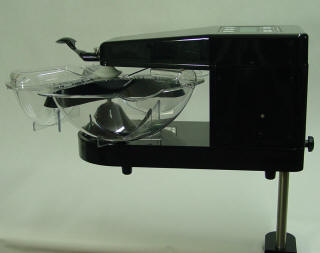August 2020 Independent Eating and Drinking Newsletter
| Independent Eating and Drinking are Wonderful |
 |
| August Newsletter Topics: |
|
| Subscribe to Newsletters |
Dietitian or Nutritionist; what is the Difference?
In this era of health awareness more people are wondering if they should seek the advice of a professional about what they are eating and how what they eat can impact their health. The question is who should you consult, a dietician or a nutritionist?
Each state regulates certification for dieticians. This may vary slightly from state to state, however, most of this article will apply all over the United States. Let’s first discuss dieticians. Most dictionaries simply define a dietician as someone who is an expert in dietetics, but Wikipedia expands upon that definition explaining, “A dietitian is an expert in dietetics; that is, human nutrition and the regulation of diet. A dietitian alters their patient's nutrition based upon their medical condition and individual needs. Dietitians are regulated healthcare professionals licensed to assess, diagnose, and treat nutritional problems.”
To become a dietician an individual must first earn a bachelor’s of science degree with coursework completed in biology, organic, and inorganic chemistry as well as specialized nutrition coursework. After completing their undergraduate degree, dietetic students must complete 900 to 1200 practice hours in 4 different areas: clinical, food service management, community and research. Upon completion they will be expected to pass a final exam before taking board certification. The dietician will either use the credential RD (Registered Dietician), or RDN (Registered Dietitian Nutritionist). Either is standard. It should be noted that in 2024 a master’s degree will be required to become a RD. RD’s can specialize in areas like pediatric nutrition, elder nutrition, and diabetic nutrition, by pursuing further education. Typically, once credentialed, RD’s provide guidance to clients about their nutrition and the food they consume. Those who work in a hospital, nursing home, or rehabilitation setting counseling patients and assessing their nutritional needs are known as clinical dietitians. Those who work for government agencies, public health clinics, or non-profit agencies are called community dietitians and they support nutrition programs. Those who supervise food programs, such as those in a hospital, school, or in corporate setting are management dieticians.
A nutritionist can have certification, but it is not required to have any credentials to call your self a nutritionist in several states. It is recommended that before you retain the services of a nutritionist that you check to see what qualifications are required by the state you are in, otherwise you could find that the person you hire has no expertise or training whatsoever. In the states that require credentials to be a practicing nutritionist, the individual will be granted the designation of Certified Nutrition Specialist (CNS) after completing the required coursework. Qualifications to become a CNS are similar to that of a RDN, which is described earlier in this article.
Because the title of nutritionist can be used without any educational background in some state in the US it is wise to check out the educational background and credentials of any nutritionist or dietician to make sure that you are getting the best medical guidance possible from someone with an extensive expertise in dietetics.
|
Assistive Dining at its Very Best The Mealtime Partner Dining System provides the means to eat independently for those who are unable to feed themselves in the traditional way. Because of its flexible design it can be configured to meet the needs of almost any user and will allow a relaxed, enjoyable meal that is under the control of the person eating. They are free to take a bite of food when they want, and to pause between bites for as long as they choose. Thus they are empowered to have a traditional mealtime and will never be hurried. Because the Mealtime Partner has three different mounting systems, as well as it being placed directly on a table for use, it can be positioned to meet the need of a diverse range of users. The Support Arm allows the spoon to be positioned to deliver food very close to the user’s lips. A small forward movement of the head can access the food on the spoon to be eaten. The Support Arm is suitable for individuals who have very limited extremity control because it can be fine tuned to the necessary position to provide access for them. The Mounting Shafts provide comfortable positioning of the Mealtime Partner for those who sit close to a table but are unable to put their knees under the table because they are restricted by their wheelchair or for any other reason. The Shafts allow the device to pivot away from the table to allow easy access for users. Shafts come in five different heights. |
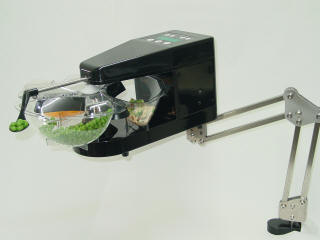 The Mealtime Partner Assistive Dining Device Mounted on the Support Arm
The Mealtime Partner Mounted on a 8-Inch Shaft |
|
For those users who are able to sit at a table with their knees
under it to eat, the Mealtime Partner can be mounted on legs.
The legs position the device at the appropriate height for each
user. Legs are supplied in three different heights. For additional information, please call us at 800-996-8607 or email us at info@mealtimepartners.com.. |
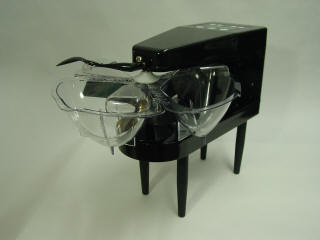
|
| The Mealtime Partner Mounted on 6-Inch Legs | |
| The Mealtime Partner Assistive Dining Device is available directly from Mealtime Partners, Inc. or Select Dealers. | |
Mounting Drinking Systems onto Standard Wheelchairs
This article will discuss some of the difficulties that people experience mounting drinking systems and electronics, like smart phones and Tablets, on their wheelchairs. If you review our previous newsletters you will find several articles that describe how to mount various drinking systems onto a variety of different types of wheelchairs. Yet many people experience difficulties with attaching anything to their powered wheelchairs.The majority of people who use a powered wheelchair own or rent a wheelchair that is described as a "standard" powered wheelchair. A standard powered wheelchair is intended to be used by people who have difficulties walking more than short distances. They have a drive system that is controlled by a basic joystick with no functions other than ‘drive’. Other than seatback adjustment and foot plate height adjustment, the chair offers no positioning or pressure relief functions. Standard wheelchairs meet the needs of a large number of wheelchair users.
However, for individuals who have congenital disorders like cerebral palsy (CP), or who have progressive or degenerative diseases like amyotrophic lateral sclerosis (ALS), or who have injuries like spinal cord injuries (SCI), a standard wheelchair often cannot meet their functional needs. Because individuals who have severe disabling conditions need a powered wheelchair to augment their limited function, they need a more complex wheelchair.
The National Coalition for Assistive and Rehab Technology (NCART - www.ncart.us) provides the following definition of Complex Rehab Technology (CRT). The description includes the definition of complex wheelchairs as follows. “CRT products include medically necessary, individually configured devices that require evaluation, configuration, fitting, adjustment or programming. These products and services are designed to meet the specific and unique medical, physical, and functional needs of an individual with a primary diagnosis resulting from a congenital disorder, progressive or degenerative neuromuscular disease, or from certain types of injury or trauma. For this article, CRT refers to individually configured manual wheelchair systems, power wheelchair systems, seating and positioning systems, and other adaptive equipment such as standing devices and gait trainers.”
Complex powered wheelchairs, as a whole, have slide-track mounting systems, or have a frame and/or handles that facilitate clamping systems being attached to them. This enables Mealtime Partners drinking systems to be mounted to these types of wheelchairs.
Standard powered wheelchairs are not as easy to mount to. It appears to be presumed by the manufacturers that the user does not need any additional equipment attached to their power chair. An example of this philosophy is the absence, on “standard” wheelchairs, of a place to mount an oxygen tank for those who need to take oxygen with them when they move around in their wheelchair.
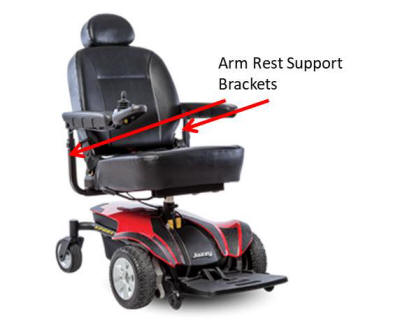
|
| Figure 1 – A Pride Jazzy "Standard" Powered Wheelchair |
As can be seen in the example of a standard powered wheelchair shown in Figure 1, above, standard powered wheelchairs are straightforward and functional without anything extra added to them. The question arises, “where do I put my drink”. If you Google wheelchair cup holders you will find a wide array of different cup holders. Almost all of them are attached to the wheelchair by a clamp that is rounded and must be mounted to a tube (i.e., round surface). Looking at the wheelchair photograph above, you will note that there are no tubular parts to which a cup holder can be attached. The armrest mounting brackets may look tubular but in fact are square. So where do you mount a cup holder?
The only way that we could find to attach anything to this type of chair (and many others that are similar) was to use a Mealtime Partners Front Mounted Drinking System and attach the Wheelchair Clamp to the armrest support bracket. Either the right or left support bracket can be used, but it is a good idea to mount on the side opposite the joystick. To use the Front Mounted Drinking System may seem like overkill for someone who has hand function but wants to have a drink available to them as they move around in their wheelchair. However, this provides a reliable way to mount a cup holder to this type of wheelchair. The following illustrations show a few methods of using a Front Mounted Drinking System on a “standard” powered wheelchair. It includes locations that provide hands-free drinking and also locations to hold a cup or bottle that will be accessible to someone who can pick up the container with their hands to drink from.
Figure 2, below, shows a Front Mounted Drinking System with a 12-inch Flex Arm mounted on the vertical armrest support bracket of a Pride Jet 2 Ultra wheelchair. A 12-inch flex arm was chosen because it extended the cup holder slightly above the armrest. Additionally, this attachment location allows the armrest to be raised and lowered without it interfering with the cup holder or its contents.
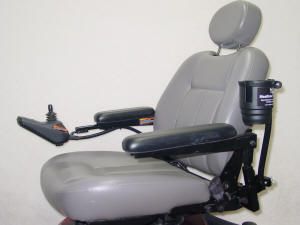
|
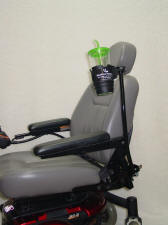
|
| Figure 2 - Cup Holder | Figure 3 - Hands Free |
Figure 3 shows the same configuration as shown in Figure 2 except the 12-inch flex arm has been replaced with an 18-inch flex arm. With the longer flex arm installed, the cup holder in now raised enough that the wheelchair user can drink directly from the cup by simply moving their head, i.e., without holding it. Thus hands-free drinking is readily available.
For most people who use their hands to lift a drink up to their lips, the most natural location for a cup holder is at the end of the armrest. In Figure 4 below, a 24-inch flex arm is installed using the same attachment location as shown in previous pictures. The flex arm is bent to approximately follow the curve of the armrest of the wheelchair and the cup holder is located at the end of the armrest. Once again, as in Figure 2, with this type of installation the armrest can be raised and lowered without disturbing the cup holder.
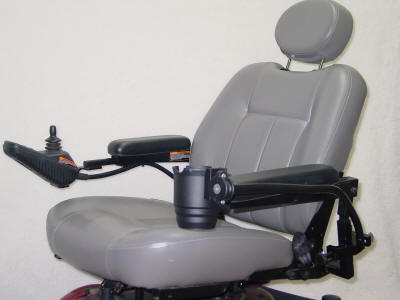
|
| Figure 4 - Front Mounted Drinking System Used as a Cup Holder |
This article shows one way of attaching a drink holder to a standard powered wheelchair. For more information or to purchase any of Mealtime Partners drinking systems, click here; otherwise you can always call 800-996-8607 for help in selecting the best drinking system for your application.
|
Did you know? Did you know that recently several “see through” public toilets were opened in some parks in Japanese cities? The architect who designed the public restrooms explained that the two things that people are most concerned about when using a public restroom are cleanliness and whether the facility is occupied or vacant. With transparent walls both of these can be seen before entering the facility. However, the idea of using a restroom without privacy is horrific to most people but actually the restrooms are only transparent when they are not in use. When someone enters the facility and locks the door the walls and door become cloudy and opaque. This was originally reported on by National Public Radio and pictures of the buildings can be seen at: https://www.npr.org/2020/08/19/903840575/transparent-public-toilets-unveiled-in-tokyo-parks-but-they-also-offer-privacy |
Click here to subscribe to the Mealtime Partners Newsletters
Please send comments and suggestions to newsletters@mealtimepartners.com
Copyright © Mealtime Partners, Inc. 2020
All rights reserved.
Mealtime Partners Website Navigation:
